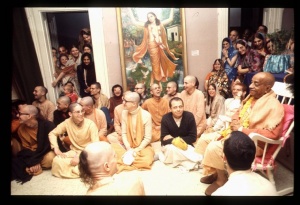CC Adi 4.50 (1975)

A.C. Bhaktivedanta Swami Prabhupada
Below is the 1996 edition text, ready to be substituted with the 1975 one using the compile form.
TEXT 50
- ataeva sei bhāva aṅgīkāra kari’
- sādhilena nija vāñchā gaurāṅga-śrī-hari
SYNONYMS
ataeva—therefore; sei bhāva—that mood; aṅgīkāra kari’—accepting; sādhilena—fulfilled; nija—His own; vāñchā—desire; gaurāṅga—Lord Caitanya Mahāprabhu; śrī-hari—the Supreme Personality of Godhead.
TRANSLATION
Therefore Lord Gaurāṅga, who is Śrī Hari Himself, accepted the sentiments of Rādhā and thus fulfilled His own desires.
PURPORT
Of the four kinds of reciprocation of loving service—dāsya, sakhya, vātsalya and mādhurya—mādhurya is considered the fullest. But the conjugal relationship is further divided into two varieties, namely svakīya and parakīya. Svakīya is the relationship with Kṛṣṇa as a formally married husband, and parakīya is the relationship with Kṛṣṇa as a paramour. Expert analysts have decided that the transcendental ecstasy of the parakīya mellow is better because it is more enthusiastic. This phase of conjugal love is found in those who have surrendered to the Lord in intense love, knowing well that such illicit love with a paramour is not morally approved in society. The risks involved in such love of Godhead make this emotion superior to the relationship in which such risk is not involved. The validity of such risk, however, is possible only in the transcendental realm. Svakīya and parakīya conjugal love of Godhead have no existence in the material world, and parakīya is not exhibited anywhere in Vaikuṇṭha, but only in the portion of Goloka Vṛndāvana known as Vraja.
Some devotees think that Kṛṣṇa is eternally the enjoyer in Goloka Vṛndāvana but only sometimes comes to the platform of Vraja to enjoy parakīya-rasa. The six Gosvāmīs of Vṛndāvana, however, have explained that Kṛṣṇa’s pastimes in Vraja are eternal, like His other activities in Goloka Vṛndāvana. Vraja is a confidential part of Goloka Vṛndāvana. Kṛṣṇa exhibited His Vraja pastimes on the surface of this world, and similar pastimes are eternally exhibited in Vraja in Goloka Vṛndāvana, where parakīya-rasa is ever existent.
In the Third Chapter of this epic, Śrīla Kṛṣṇadāsa Kavirāja Gosvāmī has explicitly accepted the fact that Kṛṣṇa appears in this material world at the end of the Dvāpara age of the twenty-eighth catur-yuga of Vaivasvata Manu and brings with Him His Vrajadhāma, which is the eternal abode of His highest pastimes. As the Lord appears by His own internal potency, so He also brings all His paraphernalia by the same internal potency, without extraneous help. It is further stated here in the Caitanya-caritāmṛta that the parakīya sentiment exists only in that transcendental realm and nowhere else. This highest form of ecstasy can exist only in the most confidential part of the transcendental world, but by the causeless mercy of the Lord we can have a peep into that invisible Vraja.
The transcendental mellow relished by the gopīs in Vraja is superexcellently featured in Śrīmatī Rādhārāṇī. Mature assimilation of the transcendental humor of conjugal love is represented by Śrīmatī Rādhārāṇī, whose feelings are incomprehensible even to the Lord Himself. The intensity of Her loving service is the highest form of ecstasy. No one can surpass Śrīmatī Rādhārāṇī in relishing the qualities of the Lord through this supreme transcendental mellow. Therefore the Lord Himself agreed to assume the position of Rādhārāṇī in the form of Lord Śrī Gaurāṅga. He then relished the highest position of parakīya-rasa, as exhibited in the transcendental abode of Vraja.